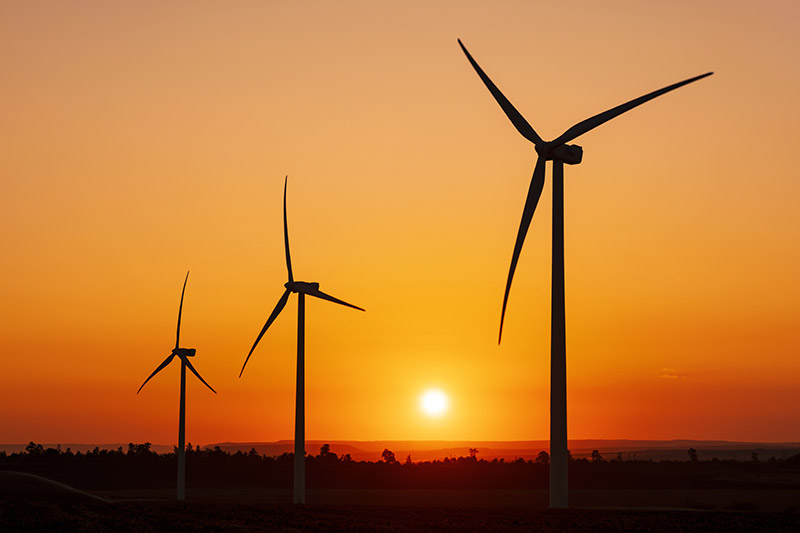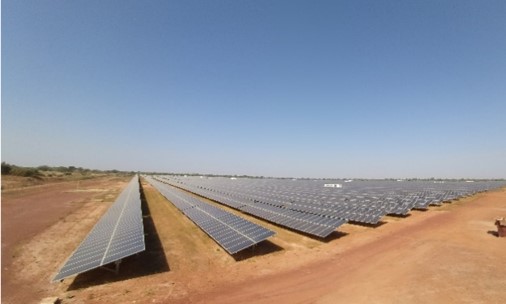Author
Daniel Wilde
Economic Adviser, Commonwealth Secretary
Author
Daniel Wilde
Economic Adviser, Commonwealth Secretary
Almost all the government owners of sovereign wealth funds are signatories to the Paris Agreement under the United Nations Framework Convention on Climate Change. This agreement commits countries to strengthen the global response to the threat of climate change by:
“Holding the increase in the global average temperature to well below 2°C above pre-industrial levels and pursuing efforts to limit the temperature increase to 1.5°C above pre-industrial levels, recognizing that this would significantly reduce the risks and impacts of climate change.” 1
Yet, despite this commitment, the world is not on course to meet these goals.2 Both trends in carbon dioxide emissions over the last three years3, and countries’ current commitments to emissions reductions in their Nationally Determined Contributions (NDC) under the Paris Agreement, are inconsistent with limiting climate change to 2°C.4 Seven G20 countries are also off-track to meet their 2030 NDC commitments.5 Recent research by the IPCC6 has highlighted that compared to current conditions even 1.5°C of global warming would pose heightened risks to eradicating poverty, reducing inequality and ensuring human well-being, with some of the worst impacts likely to be felt by small island developing states.
Recent research by the IPCC has highlighted that compared to current conditions even 1.5% of global warming would post heightened risks to eradicating poverty, reducing inequalities
This insufficient progress towards the Paris Agreement’s goals is partly explained by a lack of financing. International Energy Agency (IEA) research suggests that in a scenario consistent with limiting climate change to 2°C annual investment in low-carbon power would have to approximately double and annual investment in coal power plants sharply decline.7 2018 Research published in the journal Nature Energy demonstrates that, compared to a business-as-usual scenario8, an additional $300 billion of investment per annum is required to 2030 to meet the Paris Agreement’s 2°C goal.9
There has been a significant effort by regulators and investors to better integrate climate change considerations into financial markets and ensure investment is consistent with the Paris Agreement’s goals. Initiatives such as the Task Force on Climate-related Financial Disclosures’ voluntary framework for companies reporting climate-related risk10, and the Network for Greening Financial Services, comprising leading central banks and supervisors, have raised the profile of climate change as a financial stability risk.11 The European Commission has also been active in this area, developing an Action Plan on Financing Sustainable Growth12 which outlines a package of measures to align financial flows with the Paris Agreement.
There are also several investor-led initiatives that have also recognised the importance of climate change. The Climate Action in Financial Institutions Initiative13, and the Institutional Investors Group on Climate Change14 both work with their members to mainstream climate change considerations in investment strategies. The Climate Action 100+ initiative works with investors to ensure that the world’s largest corporate greenhouse gas emitters take action to minimise and disclose the risks, and maximise the opportunities, presented by climate change.15

Sovereign wealth funds should be at the vanguard of these efforts by investors to achieve the Paris Agreement’s goals for three overarching reasons.
First, as government-owned institutions, sovereign wealth funds’ investment policies should arguably align with the broader policy agenda and commitments of their owners, including their states’ international obligations such as the Paris Agreement. This contrasts to other large investors such as private pension funds who are ultimately responsible for investing on behalf of individuals who are not signatories to the Paris Agreement, and who may or may not be committed to its goals.
Second, many sovereign wealth funds are high-profile investors with the ability to make illiquid, long-term investments at scale. These characteristics give these investors a competitive advantage to make investments in the low-carbon economic transition, particularly in projects that may not be profitable in the short-term, but which may have attractive long-term returns.
Third, because sovereign wealth funds are owned by governments, markets and other investors often look to them for leadership. In particular, markets may consider that their government links give them additional insight into how future changes in regulation and public policy will affect returns from fossil fuels and low-carbon economic transition projects, and may follow their lead in investing or divesting from those sectors.
The economic impact of the recent Covid-19 pandemic strengthens the case for sovereign wealth funds investing to achieve the Paris Agreement goals.
The first and most obvious trend has been that the fall in oil demand due to Covid-19 has contributed to a sharp decline in oil prices and the share prices of oil companies, with the S&P Global Oil Index falling by 37% since the start of the pandemic.16 Such volatility highlights that investments in fossil fuel companies are risky in the short-term, as well as being potentially risky in the long-term with demand for fossil fuels falling as the world transitions to a low-carbon economy consistent with the Paris Agreement. This is particularly pressing for those sovereign wealth funds from commodity-dependent countries, which also have increased demands on public spending, largely financed by hydrocarbon revenues. If this situation prevails for some time, it may result in governments increasing net withdrawals from sovereign wealth funds, illustrating that investing in oil companies is inconsistent with overall financial diversification.17
The increased role governments are playing in supporting the economy during Covid-19 lockdowns may also increase demands for a larger role for the state and higher public spending in the long-term. In such an environment, there may be calls for sovereign wealth funds to increase their domestic investments and to place greater weight on the overall public good and non-financial returns when making investment decisions. If more sovereign wealth funds consider non-financial returns when making investment decisions, this may in turn speak to increased investments in low-carbon technology , low-carbon infrastructure and natural capital which offer both financial returns and an overall increase in the public good by contributing to the achievement of the Paris Agreement’s goals.

One group of sovereign wealth funds, the 50% financed by revenues from fossil fuel production,18 have an additional imperative to consider the Paris Agreement in their investment strategy. Achieving the Paris Agreement’s goals requires an overall decline in the production and consumption of fossil fuels, and this may result in a decline in revenue for those funds financed by oil and gas revenues. Conversely, one way to reduce the consumption and production of fossil fuels is to increase taxes on fossil fuel production which could substantially increase the revenues received by sovereign wealth funds. Recent Commonwealth Secretariat research concluded that a 46% global tax on the revenues of oil producing companies would cause oil production to fall to a level consistent with limiting climate change to 2°C and would also raise $1.9 trillion in government revenue in 2020.19
Some governments may also draw on their sovereign wealth funds, where legally permitted, to help diversify their economies away from the extractives sector. It may well be prudent, therefore, for those sovereign wealth funds managing natural resources to carefully consider the impact of public policies to achieve the Paris Agreement on their future revenues. This might include modelling their deposits, withdrawals and total assets under management under different climate change scenarios and adapting their investment policies considering these findings.
Despite the potential climate-related impact, sovereign wealth funds continue to invest in carbon-intensive industries. For example, Saudi Arabia’s Public Investment Fund invested approximately $1 billion in total in four international oil companies in April 2020, taking advantage of a market plunge in the energy sector.20 Major oil companies, meanwhile, are continuing to invest in projects that are inconsistent with the Paris Agreement’s Goals.21 In addition, in a world where the Paris Agreement’s goals are met and greenhouse gas emission are cut, the revenues and values of fossil fuel companies and companies with high carbon emissions may fall. One study from Carbon Tracker, assessing the impact of climate change on financial markets,22 concluded that for the Paris Agreement to be achieved, 60% to 80% of the booked reserves of listed fossil fuel companies must be left in the ground. In addition, according to HSBC,23 the combined impact in a low-carbon world of lower oil and gas demand, lower oil and gas prices and unburnable reserves would be equivalent to 40-60% of the market capitalisation of affected companies. This represents a significant financial risk to sovereign wealth funds. Even if no further regulation is forthcoming to limit the burning of fossil fuels, continued rapid technological innovation in energy, resources and transportation will increasingly impact the profitability of carbon-intensive industries as cleaner solutions come to dominate.
Thus, for sovereign wealth funds that are seeking to maximise the long-term risk-adjusted rate of return, it will be essential to develop specific, detailed policies to manage climate-change-related investment risks. These policies may involve actively engaging with carbon-intensive companies to ensure that they have prudent strategies in place to manage and reduce climate-change-related investment risks overtime, divestment from carbon-intensive industries and developing techniques to integrate climate change related risks into asset valuations.
Limiting climate change also requires significant investment in the low-carbon economic transition. This will require investment in new industries, technologies, business models and production processes to decouple economic activity from carbon dioxide emissions. Sovereign wealth funds should develop detailed policies for identifying and evaluating investment opportunities in the low-carbon economic transition and for evaluating the impact of these projects towards the Paris Agreement’s goals.
The contribution sovereign wealth funds could play to achieving the Paris Agreement’s goals has been recognised by the One Planet Sovereign Wealth Fund Working Group.24 Brought together under the auspices of the Elysée Palace, this group consists of six major sovereign wealth funds who are committed to accelerating the integration of climate change issues into the management of large, long-term assets pools thereby improving long-term returns. The achievement of this goal is guided by the principles of alignment (building climate change considerations into decision making) ownership (encouraging companies to address climate change in their activities) and integration (building consideration of climate change related risks and opportunities into investment management).
The New Zealand Superannuation Fund (NZSF) is a leading member of the One Planet Sovereign Wealth Fund Group and has developed a detailed climate change strategy.25 The NZSF was established to help reduce the future tax burden of universal pensions on New Zealanders. It considers that carbon risk is currently under-priced in the market and that specific targets to reduce the carbon emissions of its holdings are thus consistent with its mandate of maximising return without undue risk to the fund.26
The climate change strategy of the NZSF seeks to reduce the fund’s exposure to fossil fuel companies and other companies at significant risk from climate change. It also includes analysing and incorporating climate change considerations into asset valuations, engaging as an active shareholder with companies around their climate change policies and searching for opportunities to invest in the low-carbon economic transition.
The NZSF also defines, targets and reports its carbon exposure. The initial targets were for a 20% reduction in the portfolio’s current carbon emissions intensity,27 compared to the benchmark portfolio, and a 40% reduction in potential carbon emissions from fossil fuel reserves, by 2020.28 As of the 30 June 2019, NZSF’s climate change strategy enabled it to reduce its carbon emissions intensity by 43% and potential emissions carbon from fossil fuel reserves by 52%.29
The One Planet Sovereign Wealth Fund Framework is an important first step in Sovereign wealth funds investing to achieve the Paris Agreement. And the NZSF provides a good example of how a detailed and effective climate change strategy can be implemented and reduce its portfolio’s exposure to carbon. The Ireland Strategic Investment Fund and Norway’s Government Pension Fund Global have made significant moves to divest from selected fossil fuel companies. While Singapore’s Temasek Holdings has committed to halving the greenhouse gas emissions of its portfolio by 2030 and to make its operations carbon neutral by 2050. This fund is also seeking to shape a carbon neutral portfolio “sooner than later.”30
Sovereign wealth funds are increasingly considering environmental risks in their decision-making process, as part of wider environmental, social and governance (ESG) management. However, few disclose details of how they undertake this process or report their carbon exposure, which leaves a question mark around their commitment to implementing climate change strategies across their portfolios. Certainly, sovereign wealth funds do not seem to have embraced so-called “green finance”. Estimates from the United Nations Environmental Programme, suggest that these types of investments may account for less than 1% of total assets under management.31
There is, therefore, considerable scope for sovereign wealth funds to further align their investment policies with the Paris Agreement’s goals. Those funds seeking to develop climate change investment policies should consider the impact of climate change on their revenues, how to increase resilience to climate change investment risk, and how they can invest in the low-carbon economic transition.

Overall, sovereign wealth funds could play a leading role in investing to achieve the Paris Agreement. Their long-term investment horizon and ability to invest at scale should give them a comparative advantage over other investors when developing investment strategies that consider climate change, but to date few sovereign wealth funds have disclosed whether or not they have developed such strategies.
Going forward, sovereign wealth funds should rectify this by improving disclosure about climate-change investment strategies and developing these strategies where they have not already done so. They should also consider how to take advantage of investment opportunities emerging from the low-carbon economic transition and understand how to reduce climate change related investment risk. These strategies should be consistent with the commitment of their government owners to the goals of the Paris Agreement.
The term Paris Agreement Goals is used here to refer to the 2°C and the 1.5°C targets.
Jackson, R. B., et al. "Persistent fossil fuel growth threatens the Paris Agreement and planetary health." Environmental Research Letters 14.12 (2019): 121001.
Emissions Gap Report 2019, UN Environment Programme
Ibid.
Intergovernmental Panel on Climate Change (2018) Special Report on Global Warming of 1.5°C.
IEA, World Energy Investment 2019, available at: https://www.iea.org/reports/world-energy-investment-2019.
We use the term business-as-usual to refer to McCollum et al (2018)’s CPoL reference case which is ”those likely to happen anyway based on a continuation of today’s trends, assuming no future tightening of energy and climate policies worldwide, as is envisioned in the CPoL reference case”.
McCollum, D.L. et al. (2018) “Energy investment needs for fulfilling the Paris Agreement and achieving the Sustainable Development Goals,” Nature Energy, doi:10.1038/s41560-018-0179-z.
See: https://www.fsb-tcfd.org/
See: https://www.ngfs.net/en
See: https://eur-lex.europa.eu/legal-content/EN/TXT/HTML/?uri=CELEX:52018DC0097&from=EN
See: https://www.mainstreamingclimate.org/
See: https://www.iigcc.org/
See: http://www.climateaction100.org/
Specifically, the S&P Global Oil Index fell by 37% from the 18th of November 2019 to the 1st of May 2020.
IMF (2020) Fiscal Policy Responses to the Sharp Decline in Oil Prices, see: file:///C:/Users/Daniel%20Wilde/Downloads/special-series-on-covid-19-fiscal-policy-responses-to-the-sharp-decline-in-oil-prices%20(1).pdf
More specifically, the IE Sovereign Wealth Fund Report (2018) examined 55 sovereign wealth funds for which data on investments and revenues were available and concluded that 26 of these funds were financed by oil and gas revenues.
Wilde, Daniel, and Roz Price. "Can a Global Oil Royalty Help to Limit Climate Change?" (2017).
David Hodardi, Summer Said and Rory Jones (2020) ‘Saudis Take Big Stakes in European Oil Companies’, The Wall Street Journal, April 2020
Carbon Tracker (2019) Breaking the Habit - Why none of the large oil companies are “Paris-aligned”, and what they need to do to get there, Available at: https://www.carbontracker.org/reports/breaking-the-habit/
Carbon Tracker & The Grantham Research Institute (2013), Unburnable Carbon 2013: Wasted capital and stranded assets.
Robins, Nick, Kirtan Mehta, and Paul Spedding. Oil & Carbon Revisited: Value at Risk from Unburnable Reserves, HSBC Global Research (2013).
See: https://oneplanetswfs.org/
See: https://nzsuperfund.nz/publications/papers-reports-reviews/how-we-invest-white-paper-climate-change/
NZSF Climate Change Investment Strategy (2019), and video presentation by Matt Whineray (CEO, NZSF) on the NZSF’s Climate Change Investment Strategy (2019) available at: https://nzsuperfund.nz/how-we-invest/balancing-risk-and-return/climate-change/
Formally this is emissions intensity per US dollar of firms’ sales (tonnes of CO2e4/$USm Sales)
Formally this is: Potential Emissions from Fossil Fuel Reserves per US dollar invested (tonnes CO2e/NAV5 $USm)
NZSF Greenhouse Gas Statement over the Investment Portfolio (2019). See: https://nzsuperfund.nz/how-we-invest/balancing-risk-and-return/climate-change/
Transcript: Opening Address by Ho Ching at Global Compact Network Singapore Summit 2019 – Reimagining Business for Resilience, 12 November 2019.
Capapé, Javier. "Financing Sustainable Development: The Role of Sovereign Wealth Funds for Green Investment." Policy Brief (2018): 1-3.